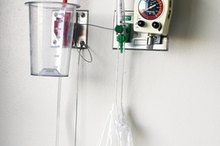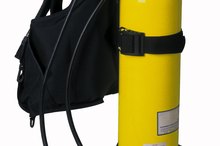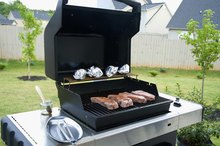Dangers of Home Oxygen Use
Home oxygen is prescribed to patients who have difficulty inhaling sufficient oxygen through their lungs. Sea-level atmospheric air contains about 21 percent oxygen, whereas home oxygen delivery systems usually administer almost 100 percent oxygen, greatly increasing the amount of oxygen absorbed into the bloodstream through the lungs. Home oxygen systems typically come in three different forms: liquid oxygen, compressed oxygen and oxygen concentrators. Home oxygen systems can be very beneficial for people with breathing difficulties; however, care should always be taken when using a home oxygen system, because they do present some dangers.
Increased Fire Risk
Contrary to popular belief, oxygen itself is not flammable. Instead, an oxygen-rich environment causes everything within it to burn faster and hotter. Oxygen can even make some materials burn that are not normally flammable. For example, Nomex, which is the material used to make the fireproof clothing firefighters wear, can be lit on fire in an oxygen-rich environment, explains the Massachusetts Executive Office of Public Safety and Security 1. Petroleum products pose a special hazard in high oxygen environments. Any product containing petroleum, such as some skin lotions, chapsticks or lubricants, may spontaneously self-ignite when brought into oxygen-rich environments.**
- Contrary to popular belief, oxygen itself is not flammable.
- Any product containing petroleum, such as some skin lotions, chapsticks or lubricants, may spontaneously self-ignite when brought into oxygen-rich environments.
Smoking Risks
Dangers of Smoking While Using Oxygen
Learn More
Because of the increased fire danger caused by oxygen, a person using home oxygen should never smoke or be in the same room as a person smoking while the oxygen tank is turned on. The flame from a match or lighter, and even the ember burning at the end of a cigarette, can cause any nearby materials--such as clothing, hair or furniture--to burst into flame. Severe burns on the face have resulted from people smoking while using home oxygen, reports an article published in the October 1998 issue of the British Medical Journal 2. Similarly, a person using an oxygen canister should stay away from candles and gas appliances, including gas stoves and water heaters.
- Because of the increased fire danger caused by oxygen, a person using home oxygen should never smoke or be in the same room as a person smoking while the oxygen tank is turned on.
Rapid Decompression
Compressed oxygen tanks also pose a danger of turning into an airborne projectile due to rapid decompression. The oxygen in compressed tanks is under extremely high pressure. If the valve on top of the tank is damaged and begins to leak, the oxygen will spray out of the tank at rapid velocity, which can cause the tank to "take off like a rocket," warns the United States Fire Administration. Compressed oxygen cylinders should always be placed in a secure position or attached to a carrier to reduce the risk of a tank falling over and damaging the valve. In addition, the oxygen tank should never be carried or dragged while holding on to the valve itself.
- Compressed oxygen tanks also pose a danger of turning into an airborne projectile due to rapid decompression.
- In addition, the oxygen tank should never be carried or dragged while holding on to the valve itself.
Additional Risks
Rebreather Vs. Non-Rebreather Mask
Learn More
Oxygen masks worn on the face for long periods of time can cause irritation to the face and may rub away the skin, leading to open sores, the British Medical Journal reports 2. Alternatively, if oxygen is delivered through tubes in the nose, which are known as nasal cannulae, the nasal passages may become very dried out, sometimes leading to cracked skin. Liquid oxygen systems carry the added risk of frostbite. Oxygen can only be stored as a liquid at very low temperatures. As a result, the metal connectors between parts of the oxygen system may also become very cold, and may cause frostbite if they come into contact with skin.
- Oxygen masks worn on the face for long periods of time can cause irritation to the face and may rub away the skin, leading to open sores, the British Medical Journal reports 2.
- As a result, the metal connectors between parts of the oxygen system may also become very cold, and may cause frostbite if they come into contact with skin.
Related Articles
References
- Massachusetts Executive Office of Public Safety and Security: Breathe Easy . . . Using Home Oxygen Safely
- "British Medical Journal"; Provision of Oxygen at Home; P.J. Rees and F. Dudly; October 1998
- Things to Know When Using Oxygen Therapy. American Lung Association. August 23, 2018
- The Long-Term Oxygen Treatment Trial Research Group. A Randomized Trial of Long-Term Oxygen for COPD with Moderate Desaturation. The New England Journal of Medicine. 2016;375(17):1617-1627. doi:10.1056/NEJMoa1604344.
- American Lung Association. Supplemental Oxygen. 2017.
- Shah SA, Velardo C, Farmer A, Tarassenko L. Exacerbations in Chronic Obstructive Pulmonary Disease: Identification and Prediction Using a Digital Health System. Eysenbach G, ed. Journal of Medical Internet Research. 2017;19(3):e69. doi:10.2196/jmir.7207.
- Turan O, Ure I, Turan PA. Erectile dysfunction in COPD patients. Chron Respir Dis. 2016;13(1):5–12. doi:10.1177/1479972315619382
- Traveling with Oxygen. American Lung Association. October 3, 2018
- Nishimura M. High-flow nasal cannula oxygen therapy in adults. J Intensive Care. 2015;3(1):15. Published 2015 Mar 31. doi:10.1186/s40560-015-0084-5
- Abdo WF, Heunks LM. Oxygen-induced hypercapnia in COPD: myths and facts. Crit Care. 2012;16(5):323. Published 2012 Oct 29. doi:10.1186/cc11475
- American Thoracic Society. Patient Education Information Series. Oxygen Therapy. 2016.
Writer Bio
Matthew Busse has pursued professional health and science writing since 2007, writing for national publications including "Science Magazine," "New Scientist" and "The Scientist." Busse holds a doctorate in molecular biology from the University of California-San Diego.









